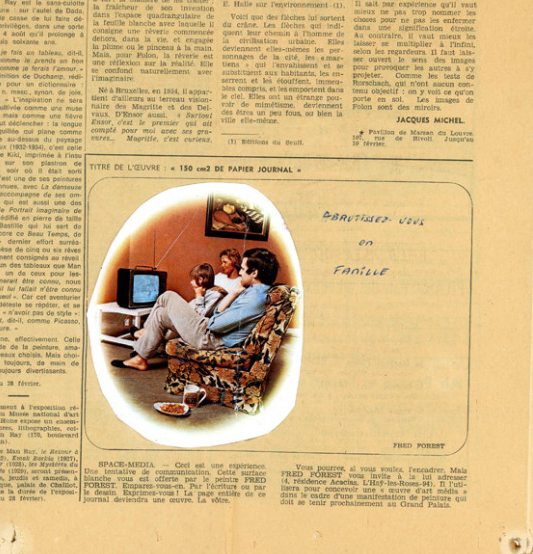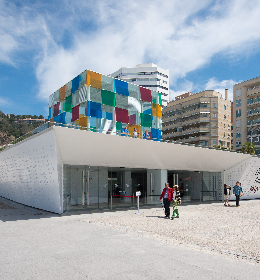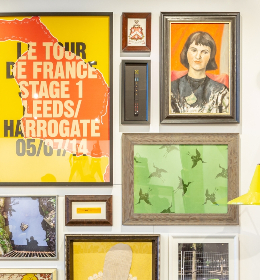Director of the Centre Pompidou Alain Seban has tweeted confirming your exhibition at the museum in 2017. We’re aware of the conflicts you’ve had with the institution, can you fill us in?
I was in conflict with the Centre Pompidou for about 40 years. When Pompidou acquired a work by Hans Haacke, I wanted to know the price and a law passed in 1978 that obliges a certain transparency among institutions. I entered into a legal battle which lasted many years, one that I lost. Now if you ask the Centre Pompidou for a price of an artwork, you cannot have it. My criticism was against this speculation, it was a question of ethics. During my exhibition in Enghien-les-Bains in 2013, Alain Seban sent me a reconciliation letter apologizing for what had happened in previous presidencies. He offered to meet. He didn’t know my work, but appreciated my sincerity and my integrity as a unique and innovative characteristic.
In 1972, you published a blank space measuring 150 cm2 in the French newspaper Le Monde, where you invited the public to draw and write in the space then send it to you.
Yes, it was my first work interacting with the public without using traditional methods. I used the paper as a source of creation, not as form of communication.

After 772 replies, you went on television on Antenne 2, with one minute of ‘nothing’ during prime time midday news.
Well, you make it sound easy, but there is a lot of preparatory work. To publish the white square in Le Monde, it took me two years of work. I took the directory and looked up journalists. The press is dubbed the « Fourth Estate » for a reason, and Le Monde was not an innocuous choice. This got me noticed straight away. I understood at the time the importance of mass media and social networks.
You’re a pioneer. Few artists at the time seemed to understand the importance of the Internet and social networks.
I invented the Internet before it even existed. I wanted to speak out against the speculation which gained national attention. I made a plan, first I created a non-trading property company (SCI), called « mètre carré artistique ». It’s not conceptual art because it's an art anchored in reality, one that is deformed to pass on a message of protest. Second, I bought a 20-metre-square plot of land from a farmer on the Swiss border. I got a surveyor to come and divide the land into plots, which he registered with the state. Thirdly, I took one-third of a page published in the economic section of Le Monde and published « Placez vos capitaux à deux pas de la frontière suisse», « Invest your capital down the road from the Swiss border”. This plot of land way advertised to the public in a mocking way, by using typical commercial jargon. “Yesterday, you speculated on art and real estate. We have found a genius formula of speculation. In one go you speculate on both at the same time. Visit our square meter plots of land.”
I invented the internet before it even existed
Then there was a big sale at the Espace Cardin with the auctioneer Maître Jean-Claude Binoche, but it was cancelled. Instead I had to sell a non-artistic meter square piece of fabric,a portion of canvas (1meter x 1meter). So at the moment of the sale, Maître Binoche annouced «Sale of the artistic meter square plot of land forbidden by the attorney general. The artist proposes another artwork.» It was a canvas in the support-surface style, purely aesthetic, meaning without any critical message. The auction started at 1.50 French Francs and sold for 6,500.00. Pierre Restany was there and declared « I, Pierre Restany, contemporary art critic, confirm that the non-artistic meter-square by Fred Forest is indeed an artistic work of art. » The debate had come full circle. It was 1977.
It's not conceptual art because it's an art anchored in reality, one that is deformed to pass on a message of protest.
How do you define yourself as an artist ? A militant ?
I am both artist and militant. Sociologists got interested in my work before the art critics. I notably created the Sociologist Art Collective with two other artists, Hervé Fischer and Jean-Paul Thénot.
« Archéologie du présent » (Archaeology of the present day) is another of your performances, taking place in May 1973 at Gallery Germain on rue Guénégaud where a camera filmed in closed circuit.
The subject was time: the image of the street in real time. I wrote: « At that time, rue Guénégaud was…» and I showed an image of the present, as it were an image of the past. I projected the spectator into a future. It was a human testimony with Pierre Restany and Vilemn Flusser. From the end of the road, each person described what they saw from a sociological perspective (shops, lawyer’s plaques etc.).
How will the exhibition at the Centre Pompidou be presented ?
There is competition between museums to determine the type of virtual exhibition to do. My project is ongoing, but I use new technologies to retrace my last square-meter projects with the Oculus Rift headsets. The INA (France’s National Audiovisual Institute), is in charge of 500 of my videos, you can consult my museum. The exhibition at the Centre Pompidou will be based around the problems raised by the connecting ideas.
You also had a «wild» exhibition at the Centre Pompidou.
I had white stickers (like those resembling the ones for sold works of art) throughout the museum and I demonstrated that the eye was the technical element to understand the art. I prepared all the texts but the rooms had been moved afterwards. The advantage of being the artist is that you are always one step ahead of the institution. I never imagined earning money with art, I do it out of passion. I kept my freedom, I’ve never had a gallery. I am a militant because I believe that the artist must always be resistant to really earn his title.
https://www.youtube.com/watch?v=lWs5Xq61bTY
https://www.youtube.com/watch?v=Lqz63RA4Qgs









